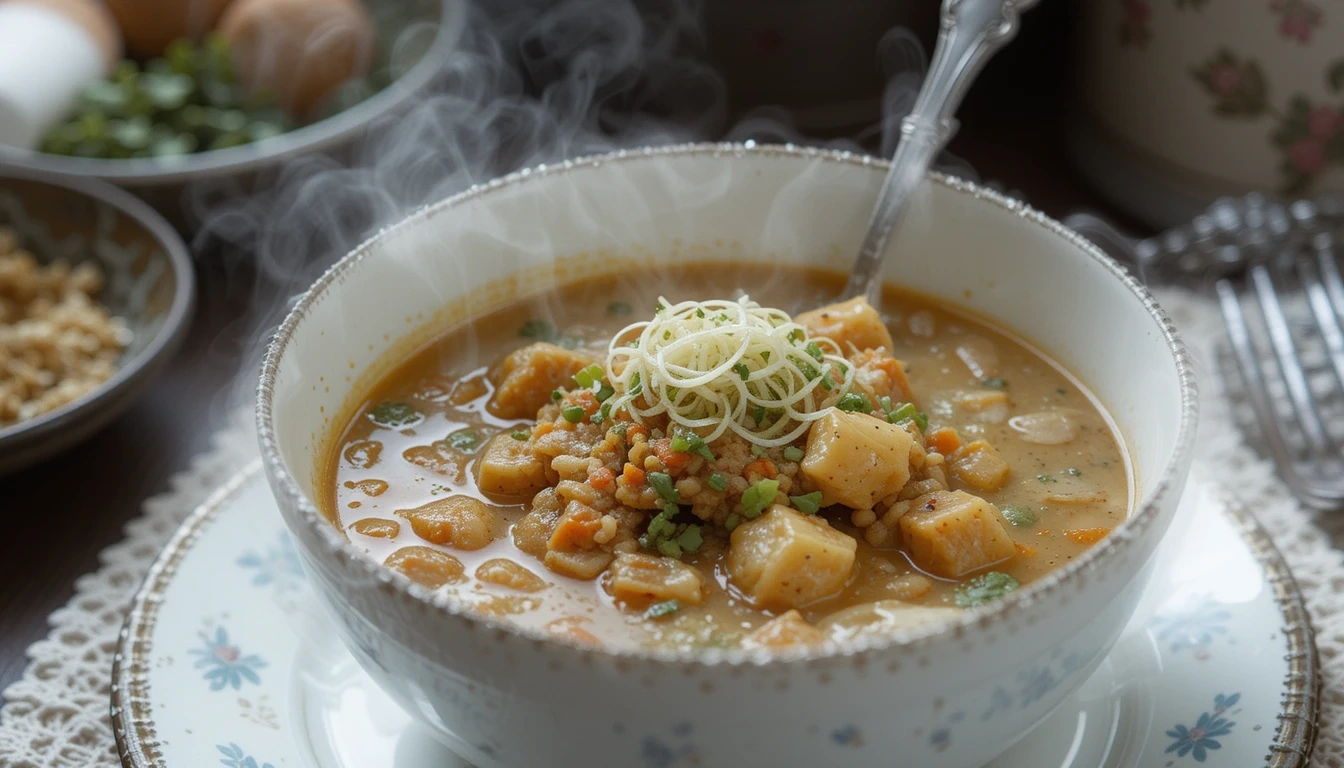When it comes to making the perfect caldo de pollo, the quality of your ingredients can make all the difference. I remember the first time I attempted this dish; I was so eager to impress my family that I rushed to the grocery store without giving much thought to what I was buying. I grabbed whatever chicken was on sale, and while it was edible, it didn’t have that rich, comforting flavor I was hoping for.
Now, I know that using fresh, organic chicken is key. The meat should be plump and free of any strange odors. I often opt for a whole chicken, as it provides a depth of flavor that cuts of meat simply can’t match.
Vegetables are equally important in this dish. I’ve learned that using a variety of fresh produce not only enhances the taste but also adds vibrant colors to the broth. Carrots, celery, and onions are staples, but I also like to throw in some corn and zucchini for a little extra sweetness and texture.
The freshness of these ingredients can elevate your caldo de pollo from a simple soup to a heartwarming meal that feels like a hug in a bowl. Whenever I visit my local farmer’s market, I make it a point to pick out the freshest vegetables available; it’s a small effort that pays off immensely in flavor.
Table of Contents
Preparing the Chicken and Vegetables for Caldo de Pollo
Once you’ve gathered your ingredients, the next step is preparation. I remember the first time I had to chop vegetables for caldo de pollo; it felt like an overwhelming task.However, I now find it to be almost meditative.
First, I rinse the chicken under cold water and then dry it off with paper towels.. This simple step helps to ensure that the skin crisps up nicely if you choose to sauté it before boiling. After that, I cut the chicken into manageable pieces, which allows for even cooking and makes it easier to serve later.
I enjoy taking my time to cut the vegetables into consistent sizes. This not only makes for an aesthetically pleasing presentation but also ensures that everything cooks evenly. I often reminisce about my grandmother teaching me how to chop onions without crying—she swore by chilling them in the fridge first!
Now, whenever I prepare caldo de pollo, I can’t help but think of her and the lessons she imparted in the kitchen. The aroma of fresh vegetables being chopped always brings back those fond memories.

The Best Seasonings and Spices for Caldo de Pollo
The real magic in caldo de pollo occurs during the seasoning process. Initially, I used to stick with just salt and pepper, but over time, I’ve discovered a world of flavors that can transform this dish into something extraordinary. A good base usually includes garlic and bay leaves, which add depth and warmth to the broth.
I remember one evening when I decided to experiment with fresh herbs; adding cilantro and thyme took my caldo de pollo to a whole new level. The fragrance that filled my kitchen was intoxicating! Another seasoning that has become a staple in my caldo de pollo is cumin.
Just a pinch can add an earthy richness that complements the chicken beautifully. I also enjoy incorporating a squeeze of lime juice right before serving; it brightens up the flavors and adds a refreshing zing. Each time I make this dish, I find myself adjusting the spices based on what I have on hand or what I’m in the mood for, making every batch unique and special.
Step-by-Step Instructions for Making Caldo de Pollo
| Ingredients | Quantity |
|---|---|
| Chicken | 1 whole, cut into pieces |
| Carrots | 2, chopped |
| Potatoes | 2, chopped |
| Onion | 1, chopped |
| Celery | 2 stalks, chopped |
| Garlic | 3 cloves, minced |
| Cilantro | 1/4 cup, chopped |
| Rice | 1/2 cup |
| Lime | 1, cut into wedges |
| Salt | To taste |
Now that you have your ingredients prepped and seasoned, it’s time to bring everything together in a pot. Begin by warming up some oil in a large pot on medium heat. If you’re feeling adventurous, you can brown the chicken pieces first for added flavor; this step is optional but highly recommended.
Once browned, remove the chicken and set it aside while you sauté your onions, garlic, and any other vegetables you’ve chosen.The scent that envelops your kitchen at this stage is absolutely heavenly.. After the vegetables have softened, return the chicken to the pot and add enough water to cover everything by about an inch.
Bring it to a boil, then reduce the heat and let it simmer for at least an hour. This is where patience pays off; as the chicken cooks slowly, it releases its juices into the broth, creating a rich and flavorful base. I often find myself checking on it periodically, stirring gently and savoring the comforting smells wafting through my home.

Tips for Enhancing the Flavor of Caldo de Pollo
To truly elevate your caldo de pollo, consider adding some unexpected ingredients or techniques that can enhance its flavor profile. One of my favorite tricks is to toss in a few whole peppercorns or even a piece of ginger while it simmers; these additions create layers of flavor that surprise and delight with each spoonful. Additionally, if you have any leftover bones from previous meals, don’t hesitate to throw them into the pot as well; they add an incredible depth of flavor.
Another tip I’ve learned over time is to let your caldo de pollo rest after cooking. Letting it rest for a minimum of 30 minutes before serving ensures the flavors blend together perfectly. When I first started making this dish, I would serve it immediately out of habit, but now I relish those moments of anticipation as I wait for dinner to be ready.
It’s during this time that I often prepare my garnishes—sliced avocado, fresh cilantro, or even a sprinkle of chili powder—adding that final touch before serving.
Discover the beloved Banana Bread recipe from Simply Recipes, renowned for its moist texture and rich flavor. This classic recipe utilizes melted butter to enhance taste and requires just one bowl for preparation, making it both delicious and convenient. With over 2,100 five-star ratings, it’s a tried-and-true favorite among home bakers. The recipe is versatile, allowing for adjustments in sugar levels and the addition of mix-ins like nuts, chocolate chips, or dried fruit to suit your preferences.

Serving and Garnishing Caldo de Pollo
When it comes time to serve your caldo de pollo, presentation matters just as much as taste. I love using large bowls that allow for generous portions of both broth and chicken. As I ladle out the steaming soup, I can’t help but feel a sense of pride knowing that I’ve created something nourishing from scratch.
The vibrant colors of the vegetables against the golden broth are visually appealing and make each bowl feel like a work of art.Garnishing is an opportunity to truly showcase your creative flair.Fresh cilantro adds a pop of color and freshness, while slices of avocado provide creaminess that balances out the broth’s warmth.
Sometimes, I’ll even sprinkle some crumbled queso fresco on top for an added layer of flavor. Each time I serve caldo de pollo at family gatherings or dinner parties, I’m reminded of how food brings people together; watching loved ones enjoy something I’ve made fills me with joy.
Warm up with the comforting flavors of Caldo de Pollo, a traditional Mexican chicken soup, as featured on Allrecipes. This hearty dish combines tender chicken leg quarters simmered in a flavorful broth with a medley of fresh vegetables like carrots, potatoes, zucchini, chayote, and onion. Seasoned with garlic, salt, and chicken bouillon, and garnished with fresh cilantro, it’s a nourishing meal perfect for any time of the year.AllrecipesAllrecipes
Storing and Reheating Caldo de Pollo
If you find yourself with leftovers—though it’s rare in my household—you’ll want to store them properly to maintain their deliciousness. After allowing the caldo de pollo to cool completely, I transfer it into airtight containers and place them in the refrigerator. It usually lasts about three to four days, but trust me when I say it rarely lasts that long!
The flavors continue to develop as it sits in the fridge, making reheating just as enjoyable as the first serving. When it comes time to reheat, I recommend doing so on the stovetop rather than in the microwave if possible. Gently warming it over low heat allows for even heating without compromising texture or flavor.
If you find that the broth has thickened too much during storage, simply add a splash of water or chicken broth while reheating to restore its original consistency. Each time I reheat leftovers, I’m reminded of how comforting this dish truly is; it’s like having a warm hug waiting for me at the end of a long day.
5 Common Mistakes to Avoid and Their Solutions
As with any recipe, there are common pitfalls that can detract from your caldo de pollo experience. One mistake I’ve made in the past is not seasoning adequately during cooking; bland soup is never enjoyable! To avoid this, taste your broth periodically as it simmers and adjust seasonings accordingly.
A little salt or spice can go a long way in enhancing flavors. Another common error is overcooking or undercooking the chicken. If you leave it simmering too long, you risk dry meat; if you don’t cook it long enough, you’ll end up with tough pieces.
To ensure perfectly tender chicken every time, aim for about an hour of simmering but check for doneness by cutting into a piece—if it’s no longer pink inside, you’re good to go! Lastly, don’t forget about garnishing; skipping this step can make your dish feel incomplete. A sprinkle of fresh herbs or a squeeze of lime can elevate your caldo de pollo from good to unforgettable!
FAQs
What is Caldo de Pollo?
Caldo de Pollo is a classic Mexican chicken soup celebrated for its soothing and tasty broth, succulent chicken, and robust vegetables.It is often served with a side of rice, tortillas, or warm cornbread.
What are the essential ingredients for making Caldo de Pollo?
The essential ingredients for making Caldo de Pollo include chicken, chicken broth, onions, garlic, carrots, potatoes, tomatoes, and a variety of seasonings and spices such as cumin, oregano, and bay leaves.
How should the chicken and vegetables be prepared for Caldo de Pollo?
Cut the chicken into pieces and chop the vegetables into small, bite-sized chunks to ensure they cook evenly. The skin and excess fat should be removed from the chicken to create a lighter broth.
What are the best seasonings and spices for Caldo de Pollo?
The best seasonings and spices for Caldo de Pollo include cumin, oregano, bay leaves, and a touch of ground black pepper. These ingredients enhance the broth’s depth and flavor, perfectly complementing the chicken and vegetables.
What are the step-by-step instructions for making Caldo de Pollo?
The step-by-step instructions for making Caldo de Pollo include preparing the chicken and vegetables, sautéing the onions and garlic, adding the chicken and broth, simmering until the chicken is cooked, incorporating the vegetables and spices, and cooking gently until the vegetables are soft.
What are some tips for enhancing the flavor of Caldo de Pollo?
Some tips for enhancing the flavor of Caldo de Pollo include using homemade chicken broth, adding a splash of lime juice before serving, and garnishing with fresh cilantro and diced avocado.
How should Caldo de Pollo be served and garnished?
Caldo de Pollo can be served in bowls and garnished with fresh cilantro, diced avocado, a squeeze of lime juice, and a side of warm tortillas or rice.
How should Caldo de Pollo be stored and reheated?
You can keep Caldo de Pollo in an airtight container in the fridge for a maximum of 3 days. To reheat, just pour the soup into a pot and warm it over medium heat until it’s thoroughly heated.
What are 5 common mistakes to avoid when making Caldo de Pollo and their solutions?
1. Preventing overcooked chicken: To prevent the chicken from becoming overcooked, take it out of the broth immediately once it is fully cooked. Using too much salt: Taste the broth as you go and add salt gradually to avoid over-salting the soup. 3. Not skimming the fat: Skim any excess fat from the surface of the broth to create a lighter and clearer soup. 4. Using bland broth: Use homemade chicken broth or high-quality store-bought broth to ensure a flavorful base for the soup. 5. Adding the vegetables too early: Add the vegetables towards the end of the cooking process to prevent them from becoming mushy.

caldo de pollo recipe
Ingredients
- Chicken: 1 whole cut into pieces
- * Carrots: 2 chopped
- * Potatoes: 2 chopped
- * Onion: 1 chopped
- * Celery: 2 stalks chopped
- * Garlic: 3 cloves minced
- * Cilantro: 1/4 cup chopped
- * Rice: 1/2 cup
- * Lime: 1 cut into wedges
- * Salt: To taste
- * Cumin
- * Oregano
- * Bay leaves
- Pros:
- * Heartwarming and comforting flavor
- * Nutritious and packed with vegetables
- * Customizable with different spices and garnishes
- * Great way to use leftover bones for extra flavor
- Cons:
- * Can be time-consuming to prepare
- * Chicken can become dry if overcooked
- * Requires careful seasoning to avoid blandnes
Instructions
- Rinse the chicken pieces under cold water and pat dry. Cut vegetables into uniform sizes.
- In a large pot, heat some oil over medium heat. (Optional: Brown chicken pieces for added flavor, then remove and set aside).
- Sauté onions and garlic until softened.
- Return chicken to the pot. Add enough water to cover chicken and vegetables by about an inch.
- Bring to a boil, then reduce heat and simmer for at least 1 hour.
- Add carrots, potatoes, and celery. Simmer until vegetables are tender.
- Season with salt, cumin, oregano, and bay leaves to taste.
- Let the soup rest for at least 30 minutes before serving.
- Garnish with fresh cilantro and a squeeze of lime. Serve with warm tortillas or rice.


1 thought on “How to Make the Perfect Caldo de Pollo Recipe: A Step-by-Step Guide”